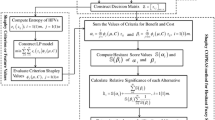Abstract
In a complex system, it is difficult to identify a specific aspect of the system in isolation to evaluate service quality. Based on the gap model of service quality, a fuzzy multiple-criteria decision-making (MCDM) model integrates the fuzzy analytic network process, the fuzzy VIsekriterijumska optimizacija i KOmpromisno Resenje in Serbian, and the improved importance–performance analysis (IPA) to provide a complete process to diagnose managerial strategies to reduce customer gaps in service quality efficiently. This fuzzy MCDM model has three significant advantages to deal with imprecise data, to simultaneously address relative customer preferences and relative customer gaps, and to improve the shortcomings in the traditional IPA. Furthermore, the case study of a cinema in Taiwan demonstrated the effectiveness and feasibility of the proposed model to diagnose managerial strategies for managers empirically.





Similar content being viewed by others
References
Chen, K.Y., Kwong, C.K., Law, M.C.: A fuzzy ordinary regression method for modeling customer preference in tea maker design. Neurocomputing 142, 147–154 (2014)
Chiou, H.K., Tzeng, G.H.: Fuzzy hierarchical evaluation with grey relation model of green gngineering for industry. Int. J. Fuzzy Syst. 3(3), 466–475 (2001)
Chiu, W.Y., Tzeng, G.H., Li, H.L.: A new hybrid MCDM model combining DANP with VIKOR to improve e-store business. Knowl. Based Syst. 37, 48–61 (2013)
Frost, F.A., Kumar, M.: Service quality between internal customers and internal suppliers in an international airline. Int. J. Qual. Reliab. Manag. 18(4/5), 371–386 (2001)
Garver, M.S.: Best practices in identifying customer-driven improvement opportunities. Ind. Mark. Manag. 32(6), 455–466 (2003)
Helm, R., Scholl, A., Manthey, L., Steiner, M.: Measuring customer preferences in new product development: comparing compositional and decomposition methods. Int. J. Prod. Dev. 1(1), 12–29 (2004)
Huang, J.J., Tzeng, G.H., Ong, C.S.: Multidimensional data in multidimensional scaling using the analytic network process. Pattern Recognit. Lett. 26(6), 755–767 (2005)
Hung, Y.H., Huang, T.L., Hsieh, J.C., Tsuei, H.J., Cheng, C.C., Tzeng, G.H.: Online reputation management for improving marketing by using a hybrid MCDM model. Knowl. Based Syst. 35, 87–93 (2012)
Kumar, R., Kumar, U.: A conceptual framework for the development of a service delivery strategy for industry systems and products. J. Bus. Ind. Mark. 19(5), 310–319 (2004)
Luk, S.T.K., Layton, R.: Perception gaps in customer expectations: managers versus service providers and customers. Serv. Ind. J. 22(2), l09–l28 (2002)
Myers, J.: Measuring Customer Satisfaction: Hot Buttons and Other Measurement Issues. American Marketing Association, Chicago (2001)
Opricovic, S., Tzeng, G.H.: Compromise solution by MCDM methods: a comparative analysis of VIKOR and TOPSIS. Eur. J. Oper. Res. 156(2), 445–455 (2004)
Parasuraman, A., Zeithaml, V.A., Berry, L.L.: Delivering Quality Service. The Free Press, New York (1990)
Shahriari, H., Haji, M.J., Eslamipoor, R.: An integrated approach for enhancing the quality of the product by combining robust design and customer requirements. Qual. Reliab. Eng. Int. (2013). doi:10.1002/qre.1548
Tsai, W.H., Hsu, W., Chou, W.C.: A gap analysis model for improving airport service quality. Total Qual. Manag. Bus. Excell. 22(10), 1025–1040 (2011)
Tsai, W.H., Hsu, W., Lin, T.W.: New financial service development for banks in taiwan based on customer needs and expectations. Serv. Ind. J. 30(14), 1–22 (2009)
Vyas, P.H.: Measuring consumer preferences for sales promotion schemes in FMCG sector in FMCG sector in an emerging market: India. Bus. Rev. Camb. 4(2), 231–238 (2005)
Zeithaml, V.A., Bitner, M.J., Gremler, D.D.: Service Marketing: Integrating Customer Focus Across the Firm, 4th edn. Irwin McGraw-Hill, Boston (2006)
Acknowledgments
The author would like to thank the National Science Council of Taiwan for providing the financial support for this research under the Grant NSC99-2221-E-424-004.
Author information
Authors and Affiliations
Corresponding author
Rights and permissions
About this article
Cite this article
Hsu, W. A Fuzzy Multiple-Criteria Decision-Making System for Analyzing Gaps of Service Quality. Int. J. Fuzzy Syst. 17, 256–267 (2015). https://doi.org/10.1007/s40815-015-0018-3
Received:
Revised:
Accepted:
Published:
Issue Date:
DOI: https://doi.org/10.1007/s40815-015-0018-3




